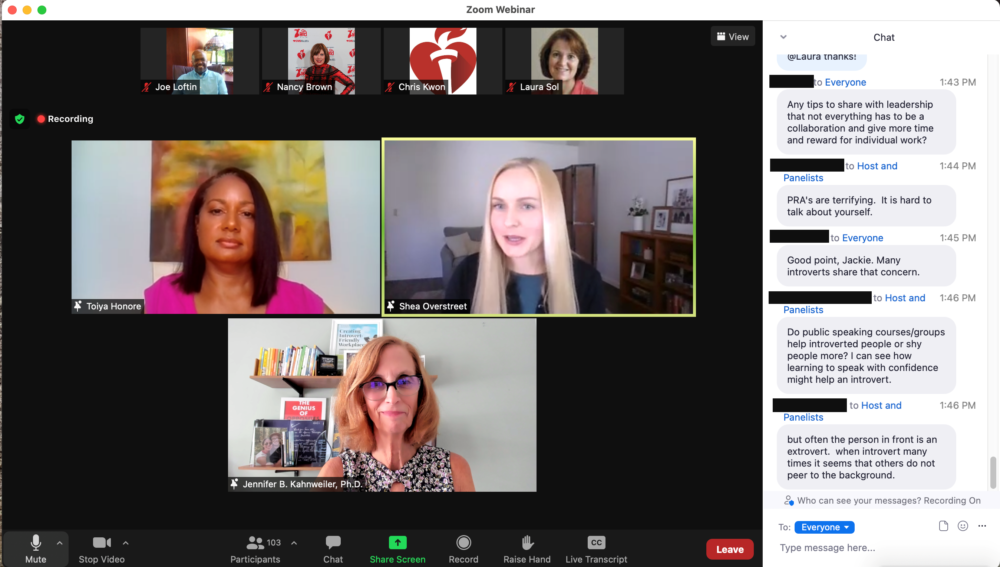I was so glad to enter to have some virtual presenting under my belt when the world changed last March 2020. I felt like I had seen it all in virtual learning – lost internet connections, slide show fiascos, and dead silence. And I knew I could manage through all those mini crises.
Through these courses, workshops, and panel presentations one theme did emerge. Introverts, those folks who are prone to think before talking, and who are not afraid to embrace silence, really seemed to blossom on these platforms.
So, when the pandemic suddenly forced all of us into virtual meeting and learning modes, I wasn’t afraid to make the transition from live gigs. I knew that my introverted clients were already comfortable and even thrived there. I even wrote about that earlier.
So, what about virtual learning works for introverted audiences? Let me share 5 of those advantages:
- Comments in the Chat – This is your best friend with introverts. They like to express themselves in writing, and the chat allows them to think and then craft questions and comments. In a presentation on introverted leadership last week, one woman opened up about her daughter’s social anxiety and received several resources and support within a matter of minutes: all through the chat. Being able to save those discussions on chat discussions , allows you to follow up with people and get a sense of the key reactions and hot issues that have emerged.
- A Vibrant Q & A – Introverts, who are often not keen about raising their hand in a live session, ask questions early and tend to do so more virtually than in person. And the responses come from others in the chat as well as from the instructor. We don’t have to wait until the end when the question might not be as relevant. What I often do in sessions where we have some time, is to ask people to unmute and ask their question aloud. Because we have had a chance to build a safe environment, they are usually willing to do that. Hearing people’s voices is yet another way to build connection.
- Focused Conversations – We were conducting conversations and panels pre-Covid. And when we all switched to a virtual work world, we soon realized that Zoom, Teams, and other platforms were very effective in communicating outside of the office. When promoting last June’s release of Creating Introvert-Friendly Workplaces, our company designed “Fireside Chats” for initial interviews with organizations’ leaders. Introverts prefer preparation time so we sent potential questions ahead of these sessions which helped them feel confident and ready to go. We have had vibrant back and forth conversations about their challenges, successes, and how they and their companies harnessed introvert talent.
- Breakout Rooms – Introverts prefer smaller group discussions and tend to self-disclose more when given the opportunity to go deeper with people. I attended an all-day retreat this year where excellent use was made of the breakout rooms. Everyone was heard and their ideas were brought back to the large group. Introverts also received visibility and connected with people globally in many of the sessions. A successful book club with Synchrony’s IT organization last December spotlighted several of the team’s leaders in these smaller, more intimate settings.
- Recordings – I have shared recordings and transcripts with my introverted clients and program participants. They love the chance to review the material and do the deep thinking that is natural for them. In fact, I know many coaches who do the same. This gives everyone the chance to reflect and respond to ideas they may have missed in the actual meeting. I often refer to these recordings to pull out key ideas to share afterwards in videos and blog posts.
I welcome the day when in-person connections truly come back, and despite popular misunderstanding, most of my introverted clients do as well. But in the meantime, we have learned a lot about how we can leverage these miraculous virtual technology tools to bring out everyone’s best, including the 40-60% of introverts in our organizations.





